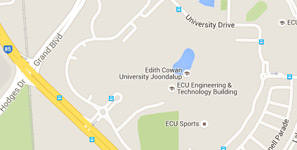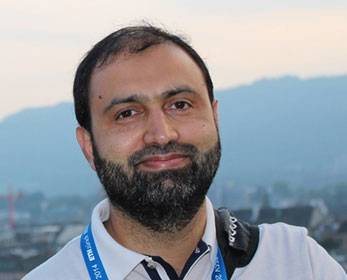Dr Gilani is a Senior Lecturer and the Raine Robson Fellow in the School of Science. He is the Co-lead of the Technology and Innovation theme at ECU Nutrition and Health Innovation and Research Institute (NHIRI) and a member of School of Science Centre for AI & ML (CAIML).
Background
Dr Gilani’s research focus is on advancing the applications of explainable artificial intelligence and machine learning algorithms in the field of medical science. His primarily concentrates on developing automated methods to detect Abdominal Aortic Calcification from low resolution DXA scans and 3D face analysis with applications to detecting Autism and Obstructive Sleep Apnoea. Dr Gilani also plays an active role in leading the Technology and Innovation Theme at the Nutrition & Health Innovation Research Institute (NHIRI) and is a core member of Centre for Artificial Intelligence and Machine Learning (CAIML) at ECU. His contributions have been widely recognized in the research community, with many of his publications appearing in Q1 (top 10%) and A* (CORE Ranking) journals and conferences such as Transactions on Pattern Analysis and Machine Intelligence, Proceedings of Royal Society (Biology), Conference on Medical Image Computing and Computer Assisted Interventions (MIICAI) and Conference on Computer Vision and Pattern Recognition (CVPR) - the globally top-rated peer-reviewed conference in the field of computer vision. He has secured over 2 million dollars in funding from 8 local and national competitive grants. As an active researcher in the field, Dr Gilani regularly reviews papers for top-tier journals and conferences and regularly gives presentation/ seminars for the general public to make them aware of the latest research in his field.
Professional Memberships
- Member of Engineers Australia
- Life member of Pakistan Engineering Council (Member of Washington Accord)
- Member of Australian Pattern Recognition Society
- Member of Medical Image Computing and Computer Assisted Intervention (MICCAI) Society
Awards and Recognition
Awards
- SZ Gilani, April 2023, “DAAD AInet fellow for Generative Models in Machine Learning”, Awarded EUR 5,000.
- J Lewis, SZ Gilani et al., Feb 2023, “Investigating genetic and lifestyle determinants of abdominal aortic calcification, and their relationship with cardiovascular disease”, 2022 MRFF Cardiovascular Health Mission, NHMRC. Awarded $1,202,213. (I am the AI lead in this project)
- SZ Gilani, Nov 2022, “Explainable AI Frameworks for Automatic Detection and Localisation of Abdominal Aortic Calcification”, Raine Research Foundation Fellowship, Awarded $248,913.
- SZ Gilani, Aug 2022, “Dynamic two-way communication using gestures for human-machine teaming”, Department of Jobs, Tourism, Science, and Innovation/Defence Science Centre, Awarded $150,000.
- SZ Gilani, Sep 2021, “Two-way communication using gestures for human-machine teaming”, Department of Jobs, Tourism, Science, and Innovation/Defence Science Centre, Awarded $19,992.
- SZ Gilani (CI-C), May 2021, “A novel machine learning approach to reducing falls and their burden in older Australians”, WA Near-Miss Awards (WANMA), Awarded $74,000.
- SZ Gilani, May 2021, “Using 3D Dense Correspondence Modelling to Predict Obstructive Sleep Apnea”, ECU School of Science New Staff and Early Career Grant Scheme. Awarded $9,600.
- SZ Gilani and Bodo Rosenhahn , November 2020, “Predicting falls in the elderly: A novel machine learning approach”. Universities Australia / Germany JRC Scheme (UA-DAAD) Awarded $24,250 and EUR 24,000.
- SZ Gilani, December 2018, “Modelling the 3D Obstructive Sleep Apnoea Face”, NVIDIA Corporation GPU (Graphical Processing Unit) grant scheme. Awarded $7,750.
- SZ Gilani, August 2017, “Discovering the Autism Facial Phenotype”, NVIDIA Corporation GPU grant scheme. Awarded $7,750.
- Associate Investigator (AI) on National Health and Medical Research Council (NHMRC) grant number APP1109057, titled “Predicting Obstructive Sleep Apnoea using 3D Craniofacial Photography” (2016 - 2018). (I wrote the methods section while I as was a PhD student at UWA). Awarded $424,715.
- SZ Gilani, May 2017, “Relationship between maternal nausea during pregnancy and facial asymmetry in autism spectrum disorder”, Telethon Kids Institute Research Grant, Awarded $15,000.
- SZ Gilani, May 2012, International Postgraduate Research Scholarship (IPRS) by the University of Western Australia to undergo PhD. Awarded $135,036.
- SZ Gilani, May 2012, Australian Postgraduate Award by the University of Western Australia to cover living expenses. Awarded $100,000 (approximately).
- SZ Gilani, May 2012, Top Up Research Scholarships by UWA. Awarded $32,000.Travel grant by UWA to present my research paper in ICPR, Stockholm, Aug 2014. Awarded $1850.
- SZ Gilani, Jun 2011, Travel grant by Higher Education Commission of Pakistan to present my research paper in ICCSA2011, Santander, Spain. Awarded USD$3100.
- SZ Gilani, Sep 2009,Travel grant by NUST to present my research paper in CAIP, Munster, Germany in Sep 2009. Awarded USD$2500.
- SZ Gilani, Dec 2009, Travel grant by NUST to present my research paper in DICTA, Melbourne, Australia. Awarded USD$3000.
Recognition
- Our research paper titled “Machine‐Learning Assessed Abdominal Aortic Calcification is Associated with Long‐Term Fall and Fracture Risk in Community‐Dwelling Older Australian Women” published in JBMR (2023) won the 2024 ECTS Best Clinical Article Award in European Calcified Tissue Society (ECTS) Congress 2024.
- Awarded the 2023 DAAD AInet Fellowship given twice a year to a group of outstanding international ECRs in the field of AI by German DAAD.
- Awarded the prestigious title of 2022 Raine Robson Fellow.
- Winner of the Australian Pattern Recognition Society ECR Award 2022 (National Level).
- Winner of Defence and Research Teaming (DaRT) -4 competition organized by Defence West, DSTG and Defence Science Center (WA) on 13 July 2021.
- My research paper titled “Fast Point Cloud Registration using Semantic Segmentation” won the DICTA 2019 DST Best Contribution To Science Award in IEEE International Conference on Digital Image Computing: Techniques and Applications 2019.
- My research paper titled "Towards Large-Scale 3D Face Recognition." won the Best Paper Runner-up Award worth $250 in IEEE International Conference on Digital Image Computing: Techniques and Applications (DICTA 2016).
- My paper titled “Sexually dimorphic facial features vary according to level of autistic-like traits in the general population” was declared the most influential paper by BioMed Central in 2016.
- My talk titled “3D Facial Morphometrics: Can We Detect Syndromes?” won the Best Talk award worth $200 in UWA Post Graduate Association Student Talks in Research (STiR), Sep 2015.
- Secured 3rd Position in Fellow of Science Exams (A levels) in the State Level Educational Board (Roughly 30,000 candidates).
Media
- Radio Interview, “Dr Syed Zulqarnain Gilani on catching drink drivers using AI” on Perth Live with Oliver Peterson, 24 Jun 2024.
- Media report, “New Camera Technology Can Spot Drunk Drivers as Soon as They Get in Their Car”, Tech Times, 25 Jun 2024.
- Media report, “New robot technology to deliver ‘tactical advantage’ to Australian Defence Force”, 1 Sep 2022.
- Media report, “Cutting edge 3D facial scans could give genetic clues to autism”, Chanel 9 National aired on 18 Sep 2021.
- Media report “Aussie Scientists Develop New Technology to Identify Sleep Apnoea Sufferers”, Channel 10 National, aired on 20 September 2019.
- “3D face scans help spot Australia's costliest sleep disorder”, IT News, 16 August 2019.
- Interview on ABC Radio “Drive” with Geoff Hutchison on “New government passport photo requirements for face recognition”, aired at 5pm on 29 June 2018.
- Interview titled, “Researchers have found a link between masculine facial feature and autism”, Channel 9, Perth Morning News, aired at 8.30am on 25 August 2017.
- Interview on ABC Radio “Mornings” with Geoff Hutchison on “3D face analysis and relationship with Autism”, aired at 9.16am on 25 August 2018.
- “3D facial recognition system may end passwords” Deccan Herald, 8 July 2018.
- “Computer algorithm links facial masculinity to autism”, Scimex (the Science Media Exchange), 25 August 2017.
- “Masculine features linked to autism”, TERESA BELCHER, Particle, 26 September 2017.
- “Mathematicians automate gender recognition.” (2014, 09). Australasian Science, 35, 14.
- “New computer model can perceive gender”, Business Standard, 17 July 2014.
- “Computers can mimic human gender perceptions”, The Conversation, 19 June 2014.
- “Computer Gender-Perception a Valuable Tool”, ACM TechNews, 18 June 2014.

